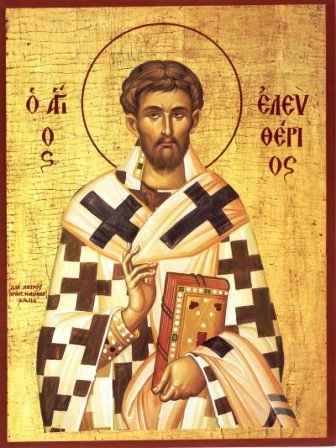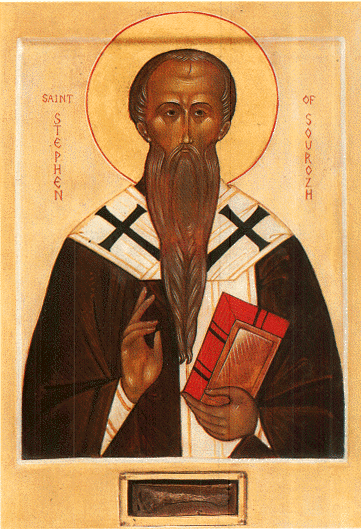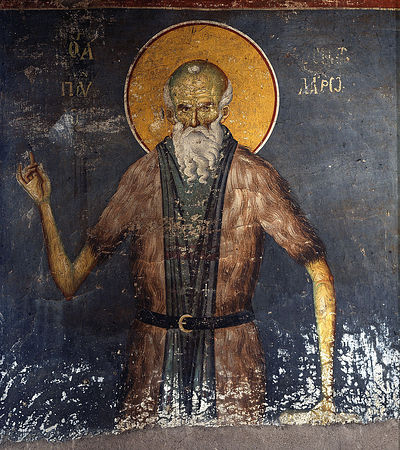|
|
The Hieromartyr Eleutherius A good fruit of a good tree, this wonderful saint had noble and eminent parents. He was born in Rome, where his father was in imperial service. His mother, Anthea, heard the Gospel from the great Apostle Paul himself, and was baptised by him. Being early left a widow, she entrusted her only son to the education and service of the Bishop of Rome, Anacietus. Seeing how greatly Eleutherius was gifted and illumined by the grace of God, the bishop ordained him deacon at the age of fifteen, priest at eighteen and bishop at twenty. Endowed by God with wisdom, he made up for what he lacked in years. This godly man was made bishop in Illyria, with his seat at Valona in Albania. He kept his flock like a good shepherd, adding to their number from day to day. The Emperor Hadrian, a persecutor of Christians, sent a commander, Felix, with soldiers, to seize Eleutherius and take him to Rome. When the furious Felix arrived in Valona and went into the church, and heard and saw God"s holy hierarch, his heart was suddenly changed and he became a Christian. Eleutherius baptised him and set off with him for Rome, as merrily as though he were going to a feast, not to trial and torture. The Emperor put the gently-born Eleutherius to harsh torture, flogging him, burning him on an iron grid, boiling him in pitch and burning him in a fiery furnace. But, by God"s power, Eleutherius was delivered from all these deadly torments. Seeing all this, Choribus the governor proclaimed that he himself was a Christian. Choribus was tortured and then beheaded, and so also blessed Felix. Finally, the imperial executioners cut off the honoured head of St Eleutherius. When his mother, holy Anthea, came and stood over the dead body of her son, she was also beheaded. Their bodies were taken to Valona, where St Eleutherius glorifies the name of Christ to this day by many wonders. He suffered in the time of Hadrian, in the year 120. A good fruit of a good tree, this wonderful saint had noble and eminent parents. He was born in Rome, where his father was in imperial service. His mother, Anthea, heard the Gospel from the great Apostle Paul himself, and was baptised by him. Being early left a widow, she entrusted her only son to the education and service of the Bishop of Rome, Anacietus. Seeing how greatly Eleutherius was gifted and illumined by the grace of God, the bishop ordained him deacon at the age of fifteen, priest at eighteen and bishop at twenty. Endowed by God with wisdom, he made up for what he lacked in years. This godly man was made bishop in Illyria, with his seat at Valona in Albania. He kept his flock like a good shepherd, adding to their number from day to day. The Emperor Hadrian, a persecutor of Christians, sent a commander, Felix, with soldiers, to seize Eleutherius and take him to Rome. When the furious Felix arrived in Valona and went into the church, and heard and saw God"s holy hierarch, his heart was suddenly changed and he became a Christian. Eleutherius baptised him and set off with him for Rome, as merrily as though he were going to a feast, not to trial and torture. The Emperor put the gently-born Eleutherius to harsh torture, flogging him, burning him on an iron grid, boiling him in pitch and burning him in a fiery furnace. But, by God"s power, Eleutherius was delivered from all these deadly torments. Seeing all this, Choribus the governor proclaimed that he himself was a Christian. Choribus was tortured and then beheaded, and so also blessed Felix. Finally, the imperial executioners cut off the honoured head of St Eleutherius. When his mother, holy Anthea, came and stood over the dead body of her son, she was also beheaded. Their bodies were taken to Valona, where St Eleutherius glorifies the name of Christ to this day by many wonders. He suffered in the time of Hadrian, in the year 120.St Stephen the Confessor of Sourozh Born in Cappadocia and educated under the care of the Patriarch, St Germanus, he went off into solitude and lived hidden from the world. An angel appeared to St Germanus and told him to make Stephen bishop of the town of Sourozh (now Sudak in the Crimea), and this the Patriarch did. Stephen brought many to the Christian faith by his zeal, and suffered much at the hands of the Emperor Leo the Isaurian because of his, Stephen"s, struggle against the iconoclasts, prophesying to the Emperor his imminent decease. After the evil death of this evil ruler, Stephen returned to his diocese and was pastor to his flock as a true man of God, departing this life peacefully at the end of the eighth century. Born in Cappadocia and educated under the care of the Patriarch, St Germanus, he went off into solitude and lived hidden from the world. An angel appeared to St Germanus and told him to make Stephen bishop of the town of Sourozh (now Sudak in the Crimea), and this the Patriarch did. Stephen brought many to the Christian faith by his zeal, and suffered much at the hands of the Emperor Leo the Isaurian because of his, Stephen"s, struggle against the iconoclasts, prophesying to the Emperor his imminent decease. After the evil death of this evil ruler, Stephen returned to his diocese and was pastor to his flock as a true man of God, departing this life peacefully at the end of the eighth century.Our Holy Father Paul of Latros Born in Pergamum, he lived in asceticism on a mountain called Latros in Asia Minor. He was glorified by his asceticism and his many miracles, and entered peacefully into rest in old age, going to the Lord in the year 950. Born in Pergamum, he lived in asceticism on a mountain called Latros in Asia Minor. He was glorified by his asceticism and his many miracles, and entered peacefully into rest in old age, going to the Lord in the year 950.Our Holy Father Pardus the SolitaryIn his youth, he was a waggoner, but because of an unintentional sin, he left the world and withdrew to the desert to live in asceticism. He lived in Palestine in the sixth century.
|